Learn to make your own cultured cream cheese, and you’ll never buy another tub from the grocery store again. It’s indulgently creamy and probiotic, plus there’s no limit to the flavors you can try! Enjoy on sourdough bagels, dolloped on homemade pancakes, or with a veggie or fruit platter!
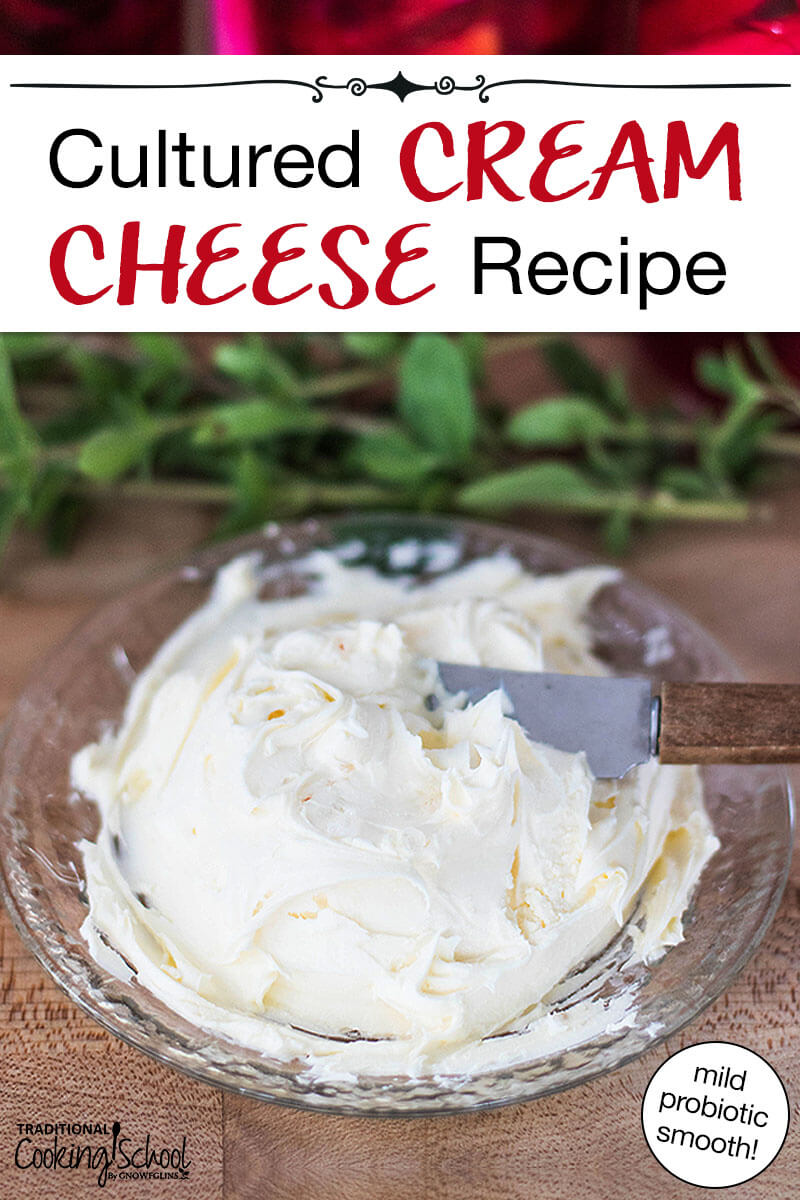
Table Of Contents
What Is Culturing?
Cultured dairy combines milk or cream with a starter culture (also known as a mother culture), encouraging these beneficial organisms to proliferate and spread their probiotic goodness throughout the milk or cream.
The many variations on the basic culturing process determine whether you end up with sour cream, milk kefir, cultured butter, buttermilk, cheddar cheese, cottage cheese or any other cultured dairy food… including the cultured cream cheese recipe below!
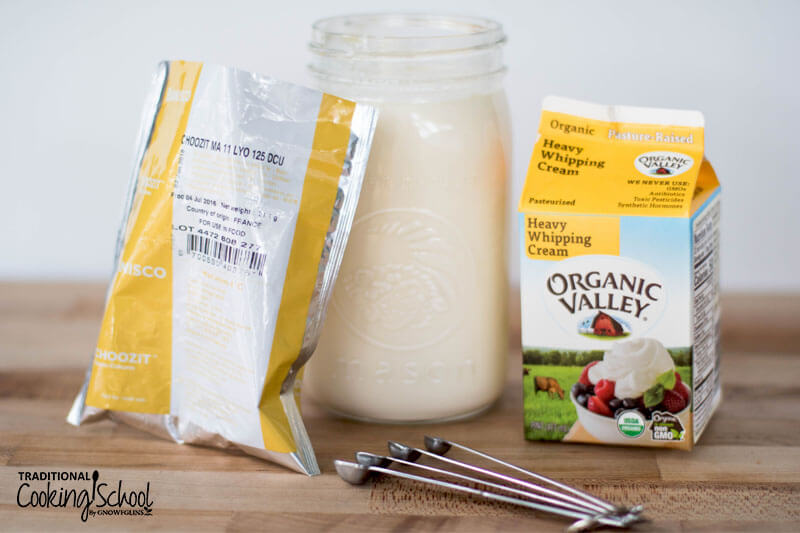
Ingredients
- Cream – If possible, source raw cream from a dairy farmer local to your area. However, cream from the grocery store will also work in this recipe, as long as it isn’t ultra-high pasteurized. You can use heavy cream or cream that isn’t as heavy. The heavier the cream, the less whey will drip out after culturing.
- Culture of choice – Choose a mesophilic cheese culture such as this one. Or, you can use buttermilk or sour cream with active cultures.
Supplies Needed
- Glass jar – You will need a quart-sized glass jar for culturing the cream.
- Paper towel or cloth napkin, plus rubber band – For covering the cream while it cultures.
- Cheesecloth – Choose 90-count cheesecloth. This is for dripping excess liquid out of the cream once it has cultured.
- Colander and bowl – To catch whey as it drips out of the cream cheese.
How to Make Cultured Cream Cheese
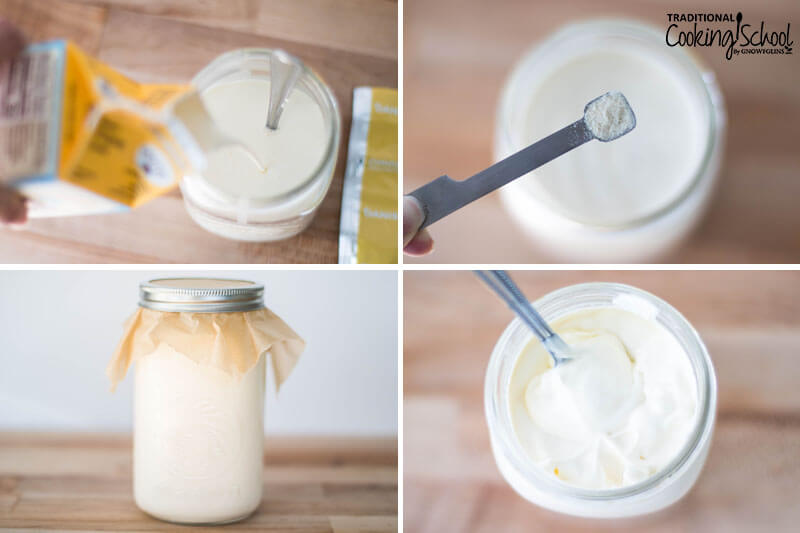
1. Combine cream and culture in a quart-sized glass jar.
2. Cover the jar with a paper towel or cloth napkin and secure with a rubber band.
3. Culture at room temperature for 8 to 24 hours until set up like firm yogurt or sour cream.
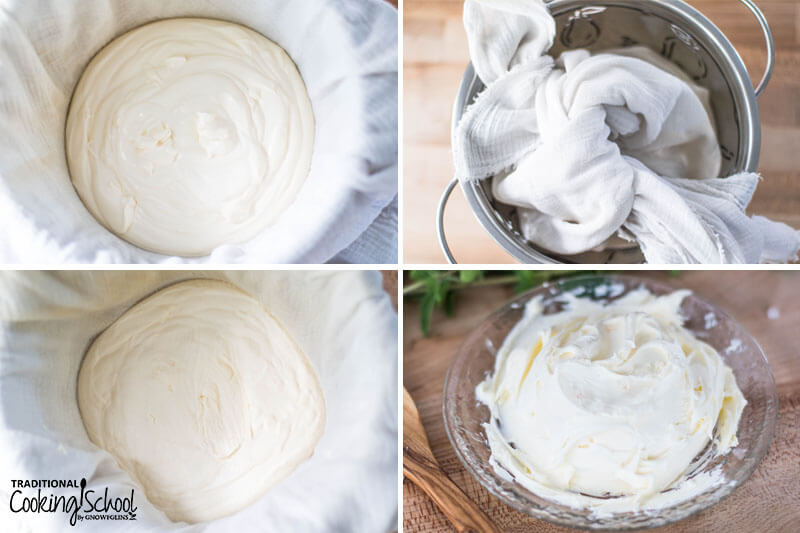
4. Drain the whey/buttermilk out of the cultured cream by hanging it in cheesecloth for 12 to 24 hours, or until the cheese is as dry as you’d like.
5. Remove the cheese from the cheesecloth and put in a jar or glass storage container. Cover with an air-tight lid. Keeps for 2 weeks in the refrigerator.
6. Enjoy plain, add sea salt to taste, or flavor (see below for ideas).
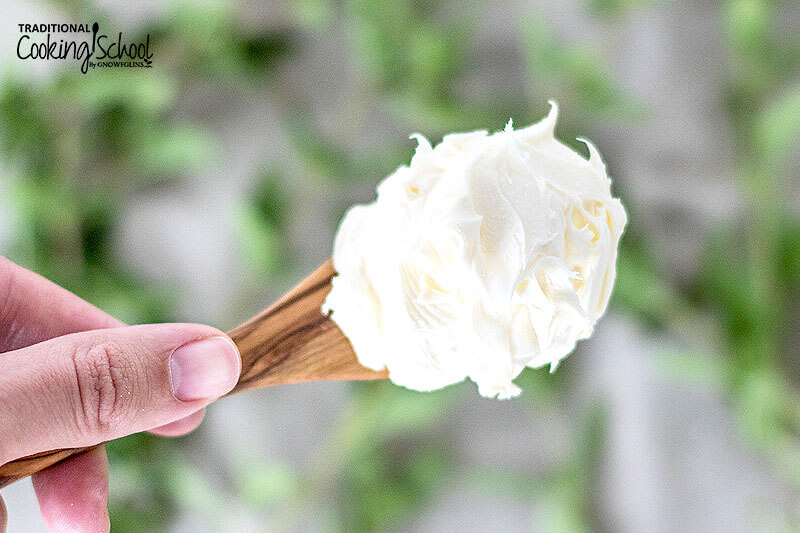
Flavored Cream Cheese
In this video excerpt from the Cultured Dairy & Basic Cheese eCourse, I show you how to make Onion-Chives or Cinnamon-Walnut homemade cream cheese.
(TCS premium members, be sure to log in and download the detailed print notes which include more flavor ideas.)
- Cinnamon Walnut – Combine 1 cup of cream cheese with 1/4 cup chopped walnuts (preferably soaked and dehydrated), 1/2 teaspoon cinnamon and 3 tablespoons of desired sweetener.
- Onion Chives – Combine 1 cup of cream cheese with 1/4 cup finely diced onions, 2 tablespoons chopped fresh chives, and 1/4 to 1/2 teaspoon sea salt.
- Spinach Onion – Mix 1 cup of cream cheese with 1/3 cup chopped, fresh spinach, 1/4 cup finely diced onion, and 1/4 to 1/2 teaspoon sea salt.
- Sun-dried Tomato Basil – Mix 1 cup of cream cheese with 1/4 cup diced, sun-dried tomatoes, 2 tablespoons chopped fresh basil, and 1/4 to 1/2 teaspoon sea salt.
- Garlic Herb – Mix 1 cup of cream cheese with 1-1/2 teaspoons of dried herbs (or a tablespoon of fresh), 1-1/2 teaspoons of crushed garlic, and 1/4 to 1/2 teaspoon sea salt.
Frequently Asked Questions
Do I need a starter culture?
You need something to inoculate and thicken the cream… however it doesn’t have to be dry powdered culture such as this one. You can also use buttermilk or sour cream with active cultures.
The advantage to using a dry powdered starter culture is, if they are new and not degraded from being stored too hot, you can ensure a better result. Having said that, either can be used in this instance and if one option is much more economical for you, you can go with that!
Where do I buy a starter culture?
I recommend this mesophilic cheese starter from Homesteader Supply!
Can I use raw milk?
Yes, you can! In fact, I recommend it as the most nutritious way of making cultured cream cheese. Raw dairy, especially once cultured, can’t be beat. 🙂
Simply skim cream from the top of your raw milk, and proceed with the recipe as written.
How long will cultured cream cheese last?
Two weeks in the fridge, or longer in the freezer.
How can I use cultured cream cheese?
Use cultured cream cheese anywhere you’d use regular, store-bought cream cheese… on English muffins or sourdough bagels, with veggies and crackers, or dolloped onto your morning pancakes!
Can I freeze cultured cream cheese?
Definitely! I like to wrap logs of cultured cream cheese in parchment or wax paper, then place individual logs in a zip-top bag for freezing, exactly the same way I store cultured butter long-term.
Other Cultured and Fermented Condiments
- Middle Eastern Kefir Cheese Balls {with free video!}
- How to Make Raw Milk Mascarpone: Soft, Probiotic Cheese
- Trim Healthy Mama Fuel Pull Cottage Cheese {homemade}
- How to Make Sour Cream
- 5-Spice Apple Chutney {lacto-fermented!}
- 43 Fermented & Probiotic-Filled Condiments
Did you make this cultured cream cheese recipe? If so, please give us a rating on the recipe card below. Then snap a photo and tag us on social media so we can see what flavors you tried!
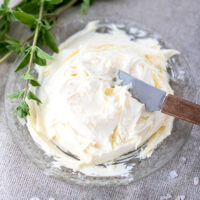
Cultured Cream Cheese
Ingredients
- 1 quart cream raw or pasteurized, heavy or not heavy
- 1/8 teaspoon mesophilic culture or 4 tablespoons buttermilk or sour cream with active cultures
Instructions
-
Combine cream and culture in a quart-sized glass jar.
-
Cover the jar with a paper towel or cloth napkin and secure with a rubber band.
-
Culture at room temperature for 8 to 24 hours until set up like firm yogurt or sour cream.
-
Drain the whey/buttermilk out of the cultured cream by hanging it in cheesecloth for 12 to 24 hours, or until the cheese is as dry as you'd like.
-
Remove the cheese from the cheesecloth and put in a jar or glass storage container. Cover with an air-tight lid. Keeps for 2 weeks in the refrigerator.
-
Enjoy plain, add sea salt to taste, or flavor (see below for ideas).
Recipe Notes
Enjoy these flavor options!
- Cinnamon Walnut – Combine 1 cup of cream cheese with 1/4 cup chopped walnuts (preferably soaked and dehydrated), 1/2 teaspoon cinnamon and 3 tablespoons of desired sweetener.
- Onion Chives – Combine 1 cup of cream cheese with 1/4 cup finely diced onions, 2 tablespoons chopped fresh chives, and 1/4 to 1/2 teaspoon sea salt.
- Spinach Onion – Mix 1 cup of cream cheese with 1/3 cup chopped, fresh spinach, 1/4 cup finely diced onion, and 1/4 to 1/2 teaspoon sea salt.
- Sun-dried Tomato Basil – Mix 1 cup of cream cheese with 1/4 cup diced, sun-dried tomatoes, 2 tablespoons chopped fresh basil, and 1/4 to 1/2 teaspoon sea salt.
- Garlic Herb – Mix 1 cup of cream cheese with 1-1/2 teaspoons of dried herbs (or a tablespoon of fresh), 1-1/2 teaspoons of crushed garlic, and 1/4 to 1/2 teaspoon sea salt.
This post was featured in 50 Fermented Salsas, Dips, and Spreads and 15 Easy Raw Cheese Recipes.
This post was originally published and written by Wardee Harmon on 6/3/11. It was updated and republished on 6/16/21.
...without giving up the foods you love or spending all day in the kitchen!

2 free books:
Eat God's Way
Ditch the Standard American Diet, get healthier & happier, and save money on groceries...
We only recommend products and services we wholeheartedly endorse. This post may contain special links through which we earn a small commission if you make a purchase (though your price is the same).


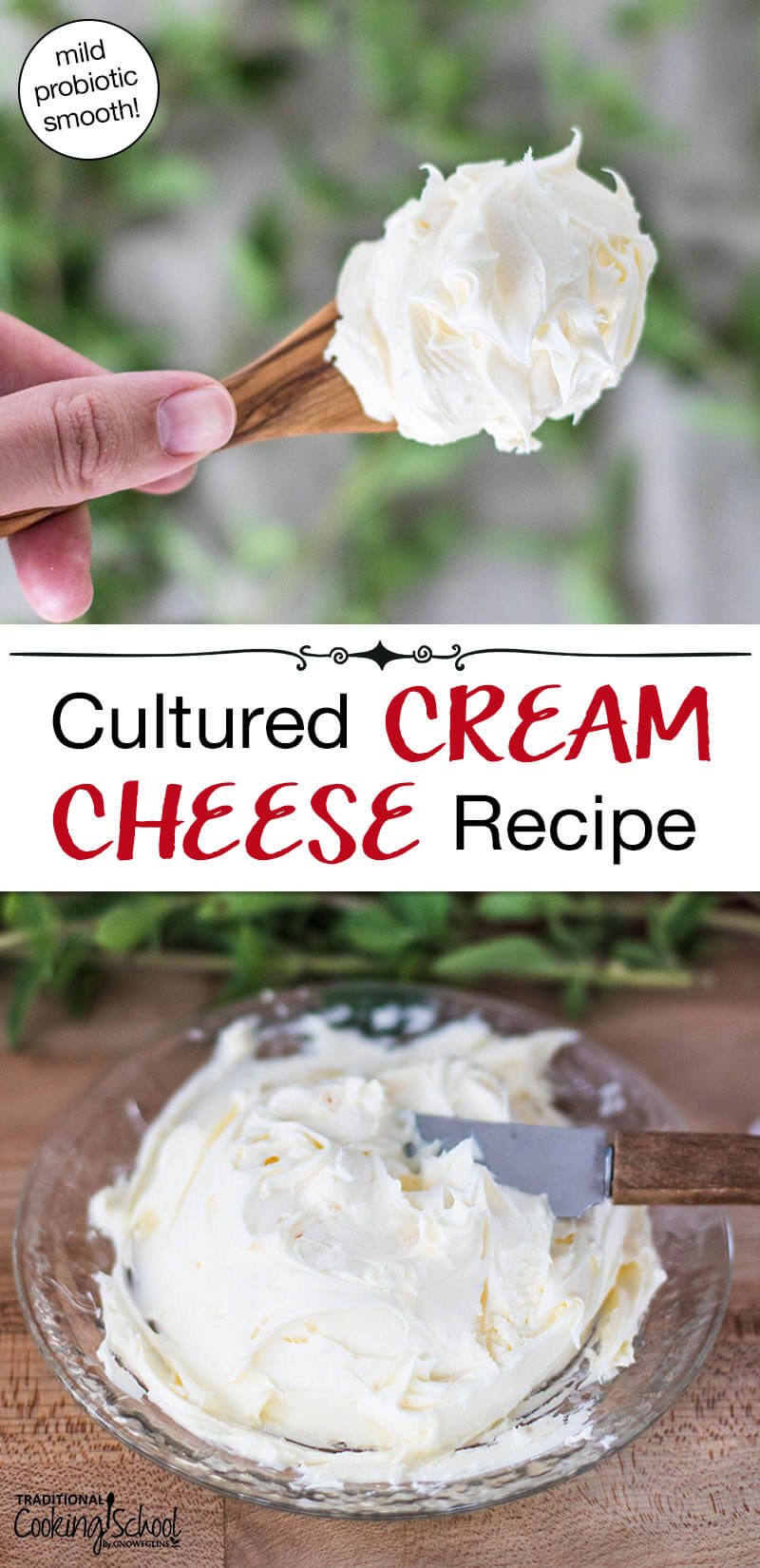
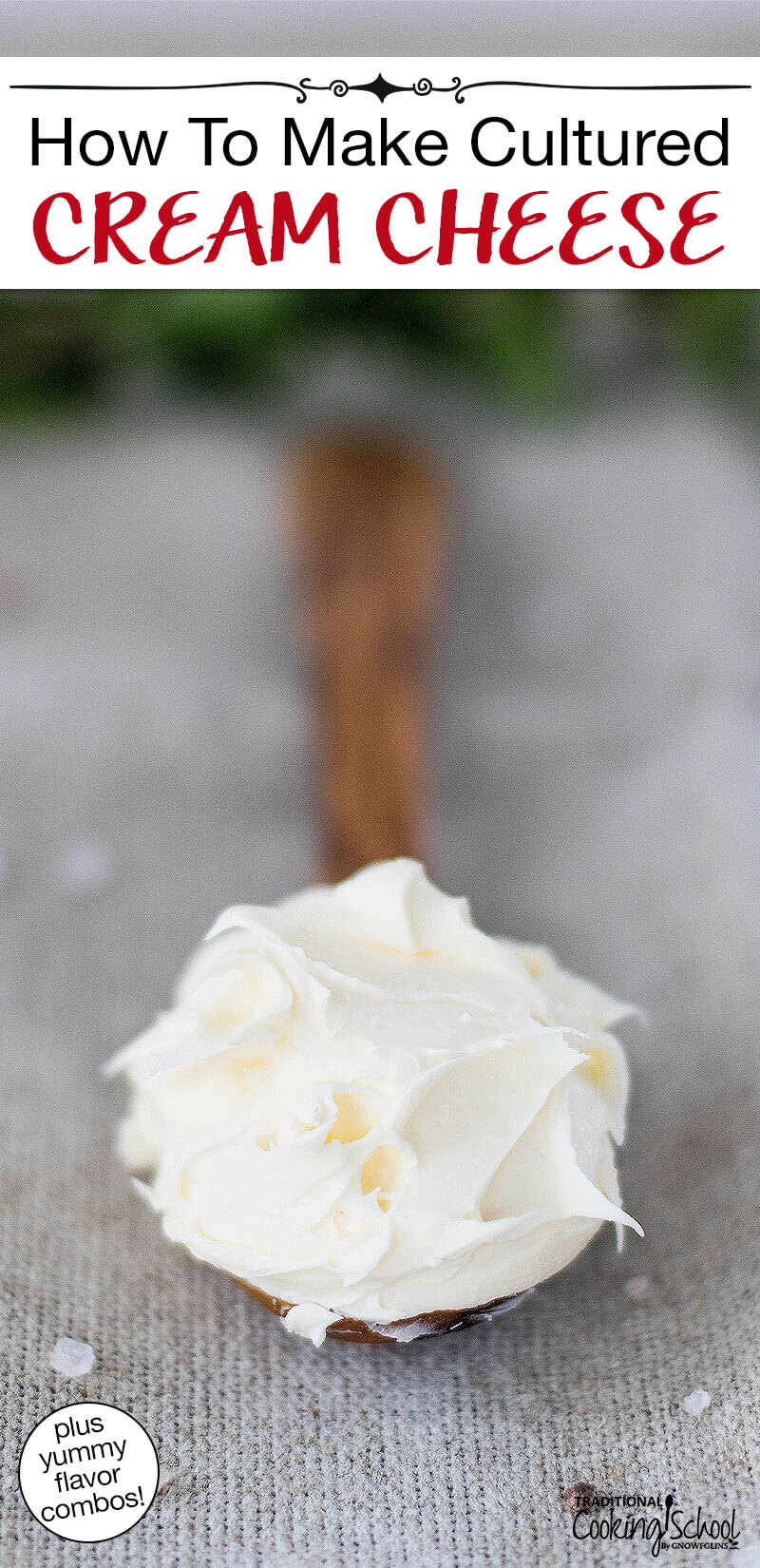
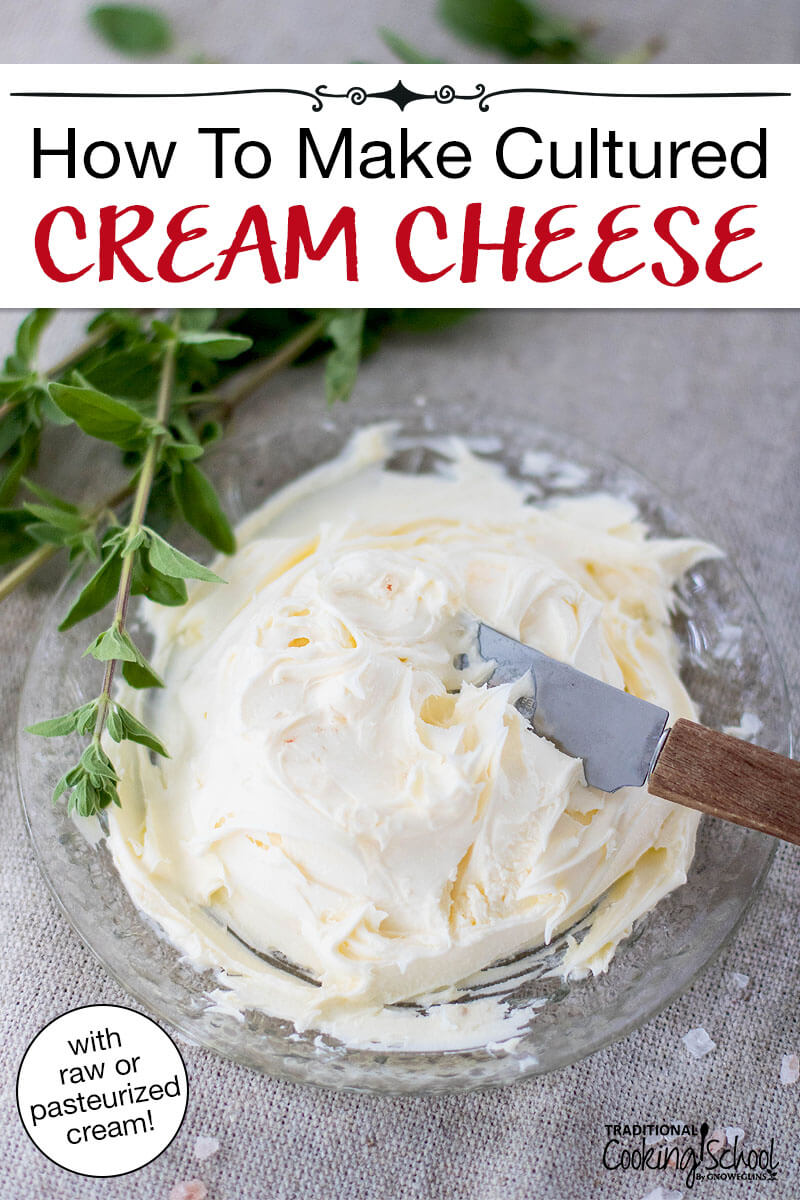
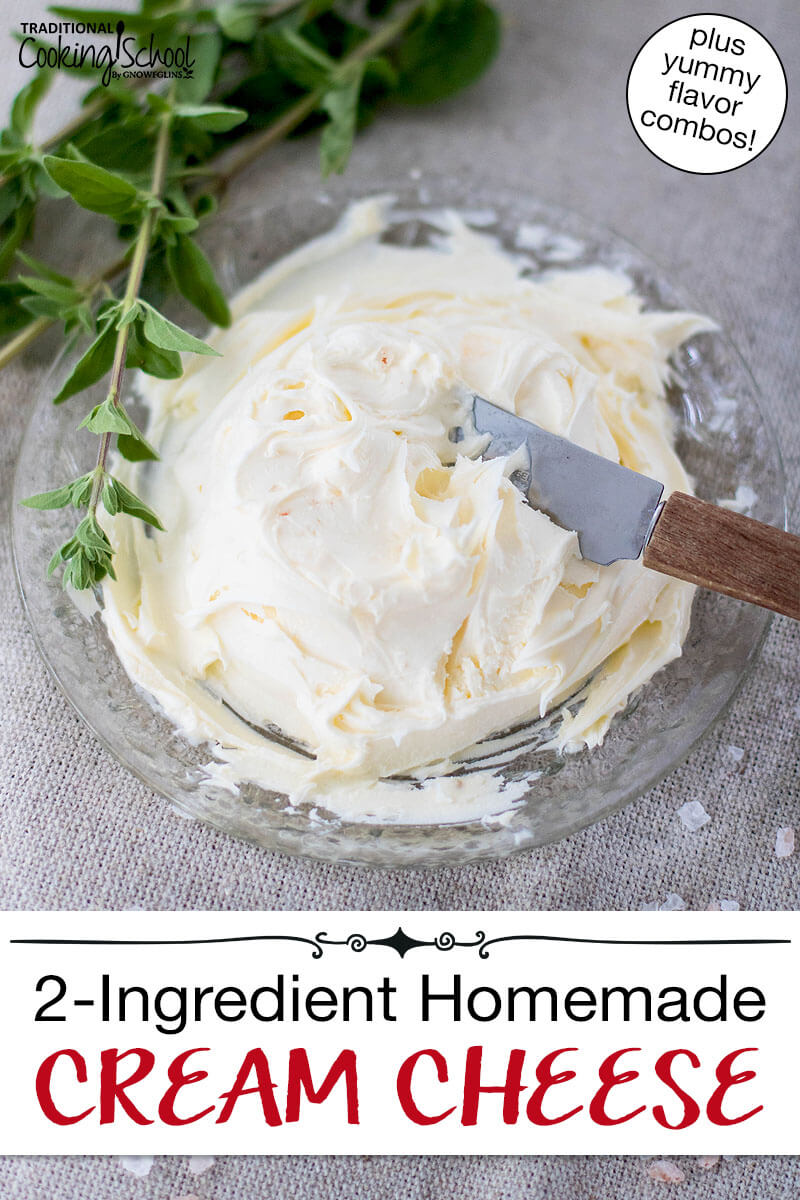

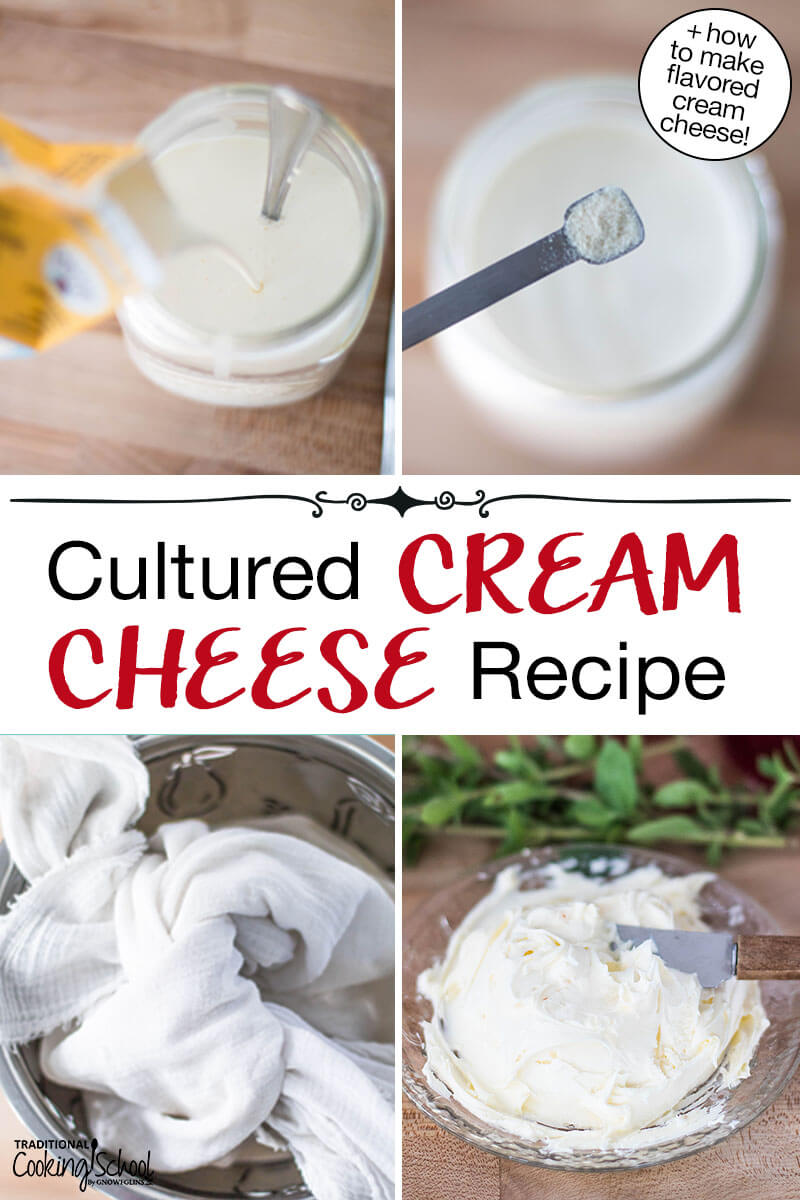
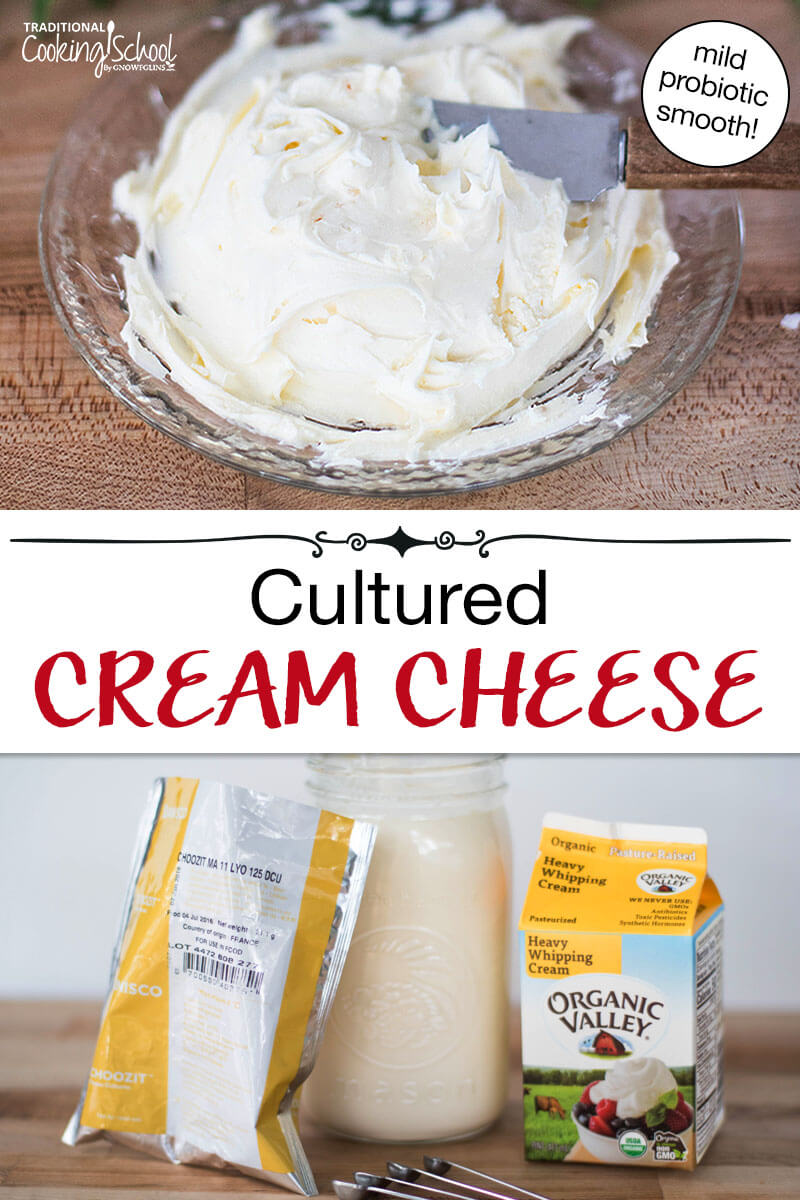
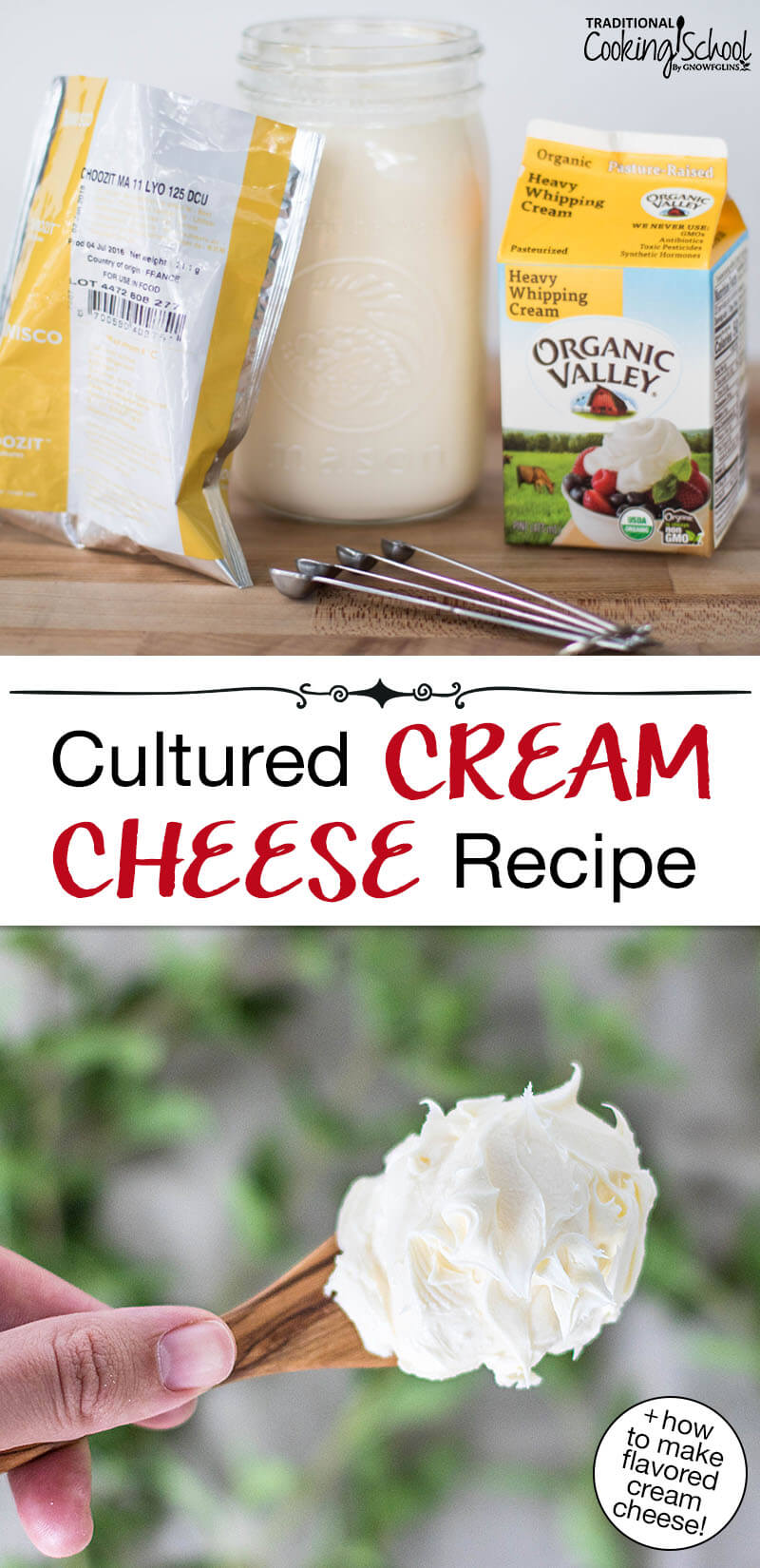
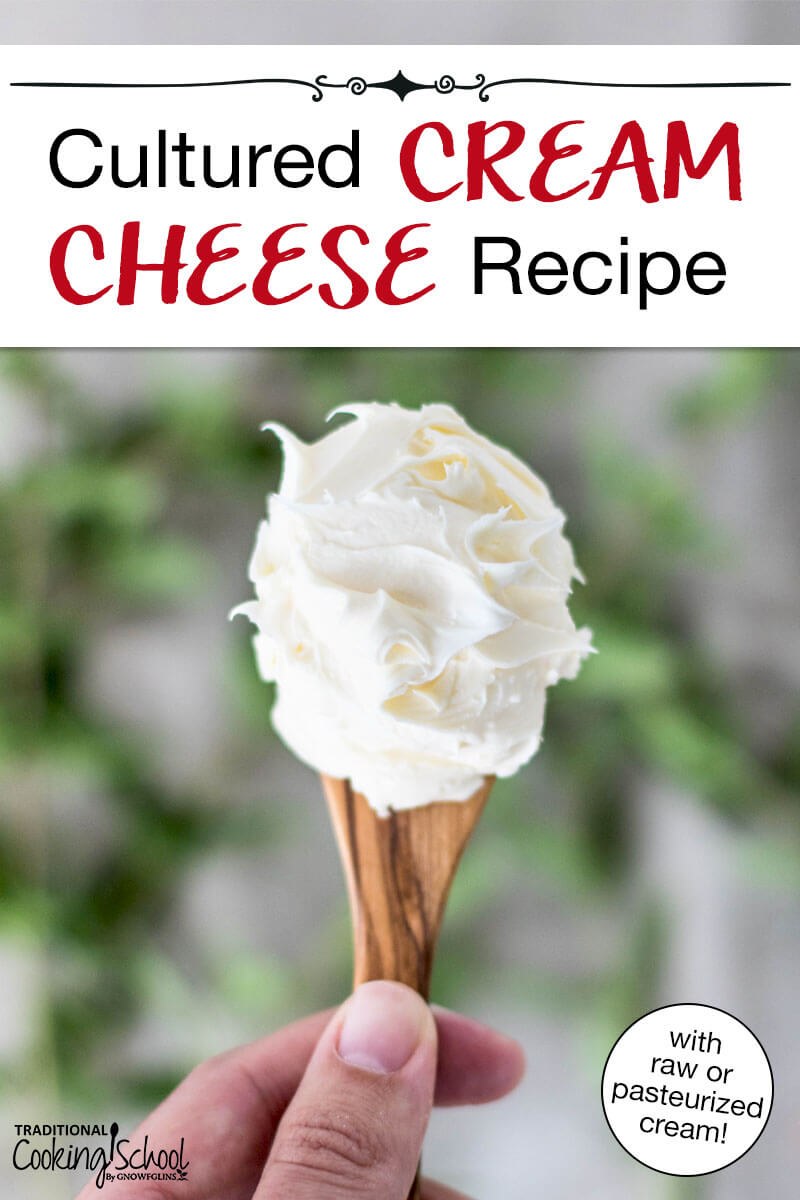

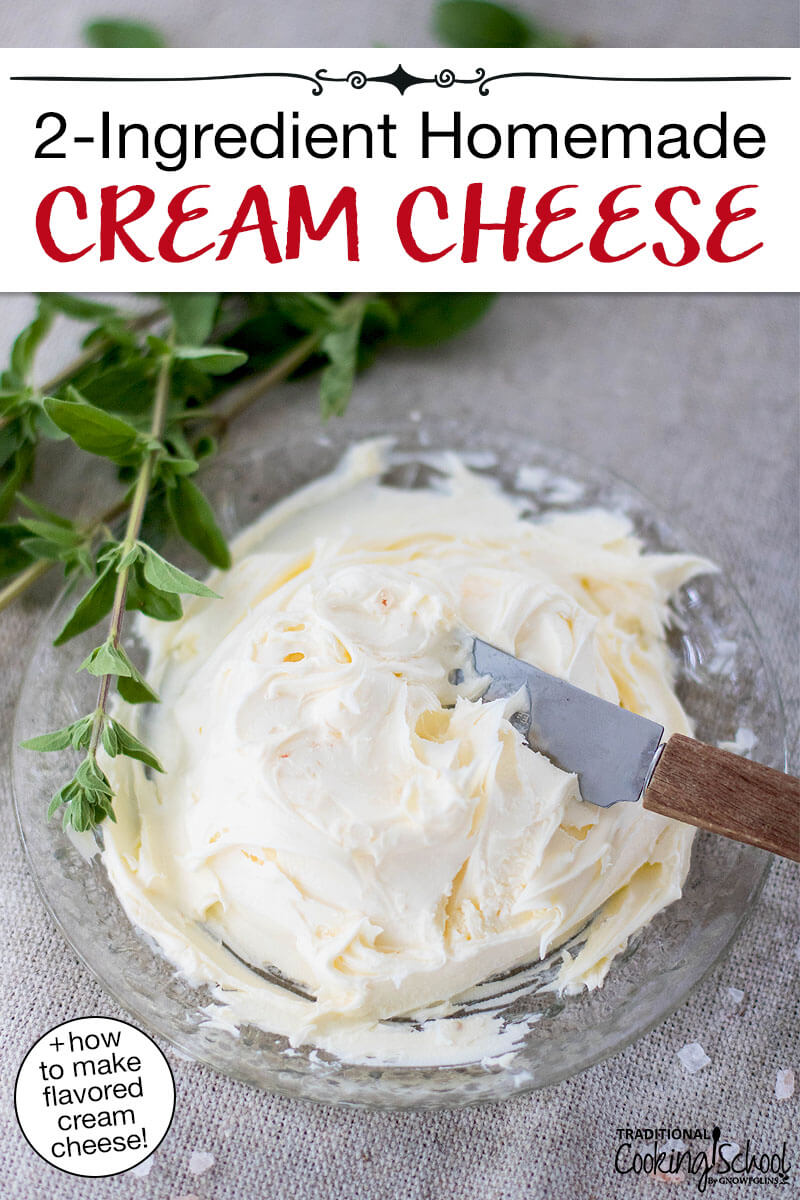
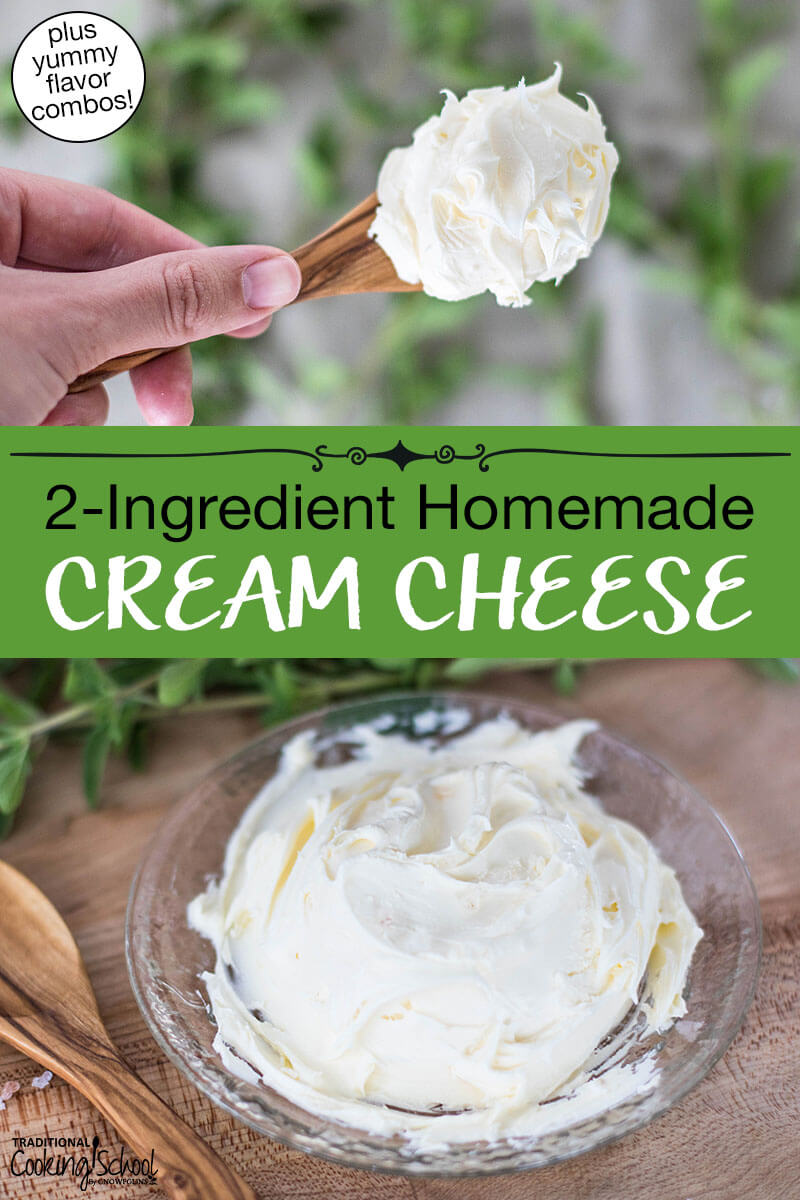
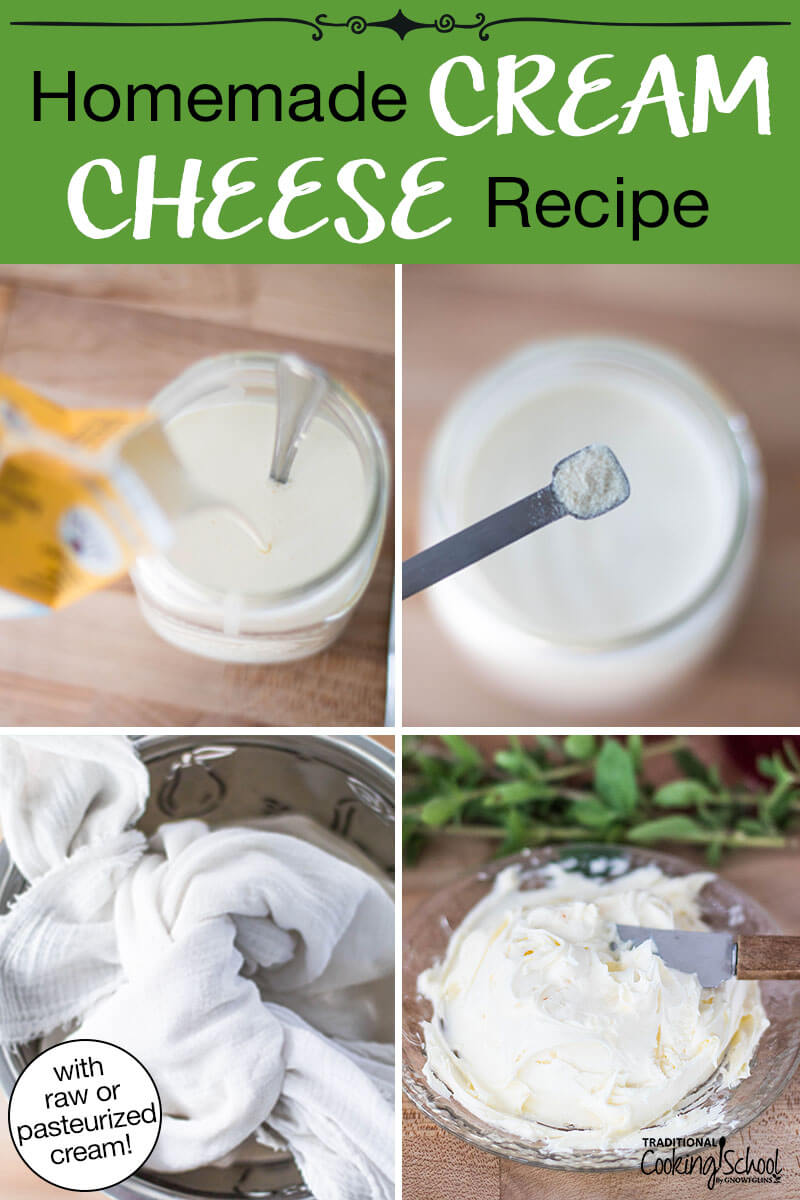

I found a site that said you can make your own mesophilic starter culture. You take raw milk and let it sit out for 24+ hours till its thick like yogurt. Then pour in ice cube trays. There you have your starter culture. I was wondering if you know is that a good way to do it? Or do you just end up with clabbered milk?? Thanks!
Evie — Yes, you can do that! You run the risk of the flavor not being consistent (clabber — soured raw milk — can taste different batch to batch) but many people do this with great success. Use it as the same rate as a prepared mother culture (1 T to 1 cup of milk).
Yay! I recently made curds and whey. I then used the curds in recipes calling for sour cream, yogurt, and cream cheese. Yes, I had to adjust for the liquid content, but it was deeeelish! Good to know I can freeze it for later!
The flavored cream cheese looks delicious, by the way! I was looking into getting a mesophilic starter culture so I could make it. That’s how I ran into this other site. 🙂
Thank you!
Thank you for this post! My daughter and I love making different kinds of spread for our wraps. I think it’s time to make our own cream cheese. You make it seem so easy! Thank you!
Hi Wardee,
Can I use whey as mesophilic culture?
Thanks
Martine
Martine — No, I don’t think so. Whey is acidic from the get-go and may end up curdling your cream way too fast into curds and whey. The mesophilic bacteria produce acids slowly over time to thicken it just right.
Thanks Wardee
So I will try with buttermilk
Martine
Thanks Wardee
So I will try with buttermilk
Martine
Yes! Though not the kefir itself — use about a tablespoon of grains per quart of cream to culture it. Then of course remove the grain before proceeding, but I know you know that. 🙂
Oh, thank you!
probably a very ignorant question, but are you able to freeze this cream cheese as you would store bought? If so, would you add the flavorings before or after freezing since it has no preservatives?
RG — You can freeze it, yes. Whether or not you add the other ingredients before or after doesn’t matter. If there are some that don’t freeze well, you’d probably want to wait on those.
Wardee, seeing you struggle a little with removing the cheese cloth from the stick reminded me to share something small but exciting…to homesteader types anyway! LOL I recently added a hook underneath a shelf in my laundry. The shelf is above a counter so when I need to hang things like cheese or jelly the bowl sits on the counter and whatever is hanging goes on the hook above…it’s so easy now! 😎
hi i made my own starte from an online recipe from cultured buttermilk. The cream cheese recipe called for 2q half and half and 4 ounces of the starter if homemade. it said it would take abot 12 h to set and mine still has a consistecy of half and half. i guess what i wont to know is if it will take longer useing my own homemade starter?
Will this cream cheese melt well (like in a cream sauce over noodles?) or should it stay cold to stay creamy?
Rhonda — This will be creamy either cold or at room temperature. By melt, if you mean melt like butter — yes, it will do that. But it doesn’t melt like cheddar cheese, not that kind of melt. I hope this helps! 🙂
I was wondering if you can make this with a non-dairy cream like coconut or soy? My husband is allergic to milk, but loves cream cheese.
Dawn — I really don’t know. I’m not sure the culture would be able to eat anything in non-dairy creams (it needs a food source). I’m sorry I can’t help with this. 🙁
Hi Wardeh,
When you make your soft cheese (of any type), do you discard your cheese cloth every time? Or wash and reuse?
Hi Amy,
You can wash and reuse. These directions come from our Cultured Dairy eCourse: To clean the cheesecloth: Pull apart layers. Rinse each in cool water. Boil for 20 minutes or wash in a sterile cycle of your washing machine to sterilize it. Hang to dry.
Millie
GNOWFGLINS Support Team
Thanks Millie!
Could I use goat milk?
Is there creme you can get from goat milk?
I was just wondering about goat milk as well. There doesn’t appear to be an answer here about that. I have access to fresh goat milk, but not cow milk.
Hi, Gretchen.
You can use this recipe from our friends at Cultures for Health for a goat milk soft cheese. Here’s the link: https://www.culturesforhealth.com/learn/recipe/cheese-recipes/goat-milk-soft-cheese/?a_aid=56e447f050113
~Danielle, TCS Customer Success Team
yay. I was wondering how to jazz up some cheese I made…stumbling around over here learning this stuff, I made cheese. I put cultured cottage cheese into my raw milk and waited nearly a day and one half before pouring it into a nut-milk bag and hanging it from a cup hook under the cabinet next to the sink. It formed cheese, but, the flavor is pretty neutral. Now, it’s delish! walnuts, cinnamon and some maple syrup have transformed my boring cheese into a yummy spread for my breakfast. Thanks.
How might this be different from the “cream cheese” that results after letting whey drip from whole milk yogurt with active cultures?
Hi, M.J.,
Cream cheese is made with a different ratio of cream than yogurt which is made from more milk than cream. Yogurt, when strained is properly called yogurt cheese.
Also, the cultures (beneficial bacteria) can be different. The above-mentioned culture is completed at room temperature whereas many yogurts, are cultured with a thermophilic culture.
~Danielle, TCS Customer Success Team
What is room temperature that you refer to in this recipe? Here in the north east I keep my house about 60-62 degrees in the day and 58-80 at night to save on high heating bills here in New York. Would this require a longer time to ferment?
I meant 58-60 at night. Typing eerror!
Yes, you will need to ferment longer. 62 is not warm enough so it may not ferment well.
~Danielle, TCS Customer Success Team
I’ve tried this twice now using cultured buttermilk and Organic Valley heavy cream. It keeps turning out more like cultured butter than cream cheese. Crumbly and very hard once refrigerated. Not sure what’s going wrong? It definitely firms up after 12 hours at room temperature, and drains nicely. But the finished product is not what I was expecting.
I make my own yogurt at home, could I use that instead of sour cream for the culture?
Homemade raw milk yogurt has its own unique cultures and will not yield sour cream.
~Danielle, TCS Customer Success Team Lead
I have the same question as Melissa fr Apr 28, 2024….
I culture my own yogurt (mesophilic) on the counter. Can I use 4T of my yogurt to culture 1 quart of cream to make this cultured cream cheese?
Thank you!
Hi, Kellie,
Choose a mesophilic cheese culture, not a yogurt culture. Or, you can use buttermilk or sour cream with active cultures.
~Peggy, TCS Success